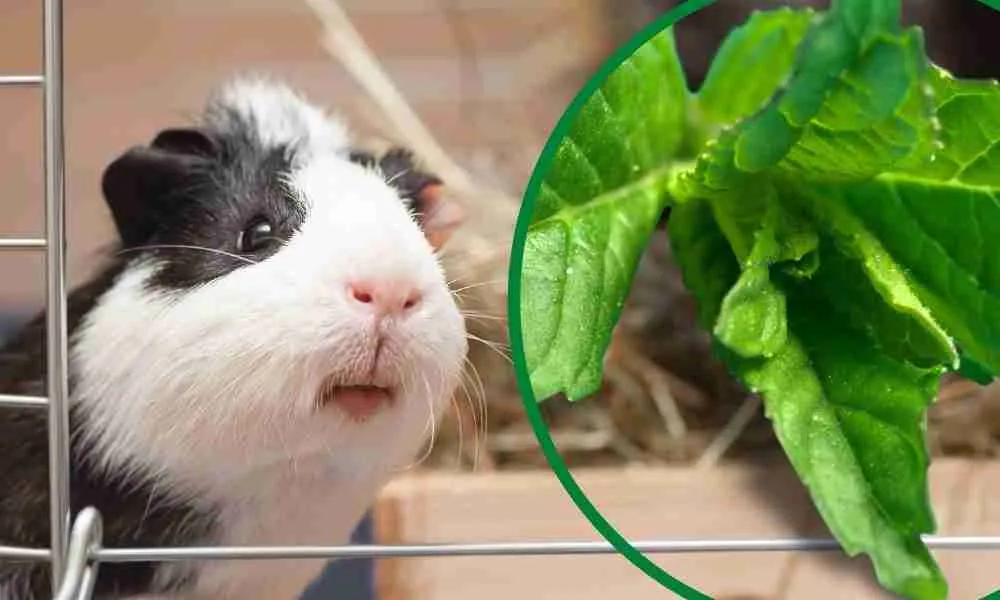Mint has a refreshing flavor, and I simply love it! People widely use mint leaves to flavor our ice cream, tea, and other food items. But what about your pets?
Is it safe for to feed your guinea pigs mint?
The answer is yes. Mint is absolutely safe for your cavies. Guinea pigs can eat both peppermint and spearmint in their diet.
It is absolutely safe to feed different parts of mint to guinea pigs. However, to prepare a healthy diet, it is recommended to mix mint with other veggies.
Mint is alone not enough to provide all the basic nutrients to your cavies. Hence, serving mint in moderation along with Vitamin C-rich vegetables is best for their health.
It is now clear that guinea pigs can eat mint safely in their diet. However, knowing the edible parts of the plant is important.
So what parts of the mint can you feed to guinea pigs?
Let’s find out more…
Table of Contents
What Parts of the Mint Can You Feed to Guinea Pigs?
Are you confused about which part of mint you should feed your cavies and which part you shouldn’t?
Read the answers to the following questions to prepare a healthy meal for your guinea pigs with mint:
Can Guinea Pigs Eat Mint Leaves?
Absolutely yes. Your cavies can safely eat mint leaves.
In fact, they love to eat mint leaves in their diet. Leaves are the favorite parts of the plant for your guinea pigs.
However, it is not a healthy habit to feed mint leaves to your pet guinea pigs every day. If you serve mint every day, make sure the portion size is very small.
While you serve mint leaves to your cavies, you need to wash the leaves thoroughly under running water to remove all dirt and pesticides.
Can Guinea Pigs Eat Mint Stalks?
Yes. It is absolutely safe for guinea pigs to eat mint stalks in their meals.
Mint stalks are very soft. So, when you cut up small-sized pieces of the mint stalk and feed it to your cavies, there is no danger of choking.
However, it is not healthy to feed mint stalks too often to your cavies. It is recommended to feed them mint stalks no more than once or twice a week.
Can Guinea Pigs Eat Mint Stems?
Yes. Mint stems are highly safe for guinea pigs to eat.
The stems are as tasty and flavorful as the mint leaves and hence, one of the loved parts of the mint to guinea pigs. Stems are closest to the leaves and can be mixed with vegetable salad along with the leaves.
Furthermore, the mint stems are very soft. Just like the stalks, when you give bite-size pieces of mint stems to guinea pigs, they can eat it without the danger of choking.
You can chop a whole stem of the mint into small pieces while preparing the veggie salad for your cavies.
Can Guinea Pigs Eat Mint Roots?
No. Mint Roots are not safe for your cavies. They are considered harmful to guinea pigs. In addition, they lack nutritional benefits.
Can Guinea Pigs Eat Mint Flowers?
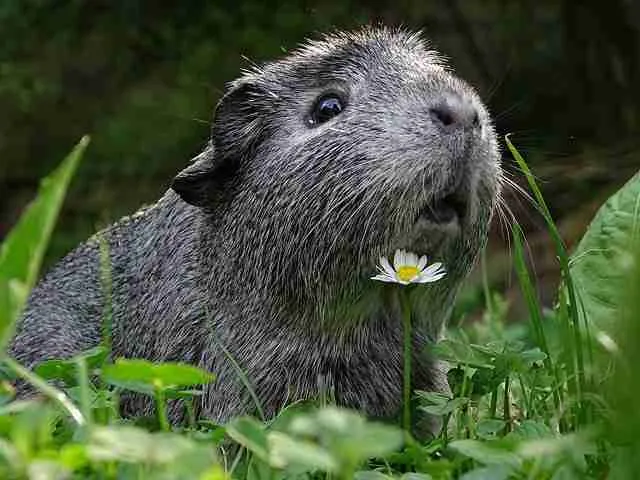
Yes. Guinea pigs can eat mint flowers, but in moderation only.
Guinea pigs love mint flowers because of their exotic smell and taste. No wonder the guinea pigs love to eat mint flowers along with the leaves in them.
Mint flowers are good for guinea pigs when you feed them in the flowers in moderation.
NOTE: It is also important to note here that guinea pigs can have allergies from eating flowers. So, before you serve them the mint flowers, make sure your cavy is not allergic to them.
The best way to find out about the allergies is to feed a small bite of the mint flowers or leaves and check the reaction.
How Much Mint Can Guinea Pigs Eat?
Your cavies might love to eat mint leaves and flowers, but you should never feed them more than 3-5 leaves each time.
Mint has a low nutritional content which is nowhere beneficial for our cavies. In fact, if cavies eat mint in large quantities on a regular basis, it can be harmful to them.
So, when you feed safe mint parts to your cavies, feed them in moderation (once or twice a week). You can also try mixing the mint leaves or flowers with other vegetables that are rich in nutrients.
It is also possible to consider mint as a supplement or palate-changing food in our cavy’s diet.
No matter how much they ask for the mint, you must never make mint a staple in their diet.
What If My Guinea Pig Eats Too Much Mint?
Mint is safe for your cavies. But only as long as you are feeding it in moderation to the guinea pigs and avoid the roots in their diet.
Feeding mint in excess to guinea pigs can give rise to allergic response and discomfort in them.
So, if your guinea pig has eaten too much mint, observe these reactions below:
- Allergies
- Constipation
- Loss of appetite
- Irregularity in defecation and bowel movement
Solution: If your guinea pig ate too much mint in their diet, don’t wait for them to show these symptoms or suffer the discomfort. Take your guinea pig to the vet immediately.
However, it is always best to avoid feeding mint in excess to guinea pigs.
You can instead try to feed them with veggies rich in Vitamin C and other micronutrients, like, broccoli, cilantro, parsley, spinach, bell peppers, etc.
How Often Can Guinea Pigs Eat Mint?
You can serve mint to guinea pigs twice a week to avoid health problems in them.
It is clear from the above-mentioned points that overfeeding mint to cavies can lead to several serious health issues. Hence, when you prepare their meal, add no more than 2 leaves of mint each time.
It is your responsibility to control the mint intake of your cavies. They hardly know when to stop eating.
Nutritional Facts of Mint
Before you start feeding mint to your cavies, here we have some interesting facts about the nutrients present in the mint.
There are TWO major types of mint available in the market for feeding cavies.
1. Spearmint:
Firstly, when you are out in the market to shop for mint in the grocery shop, the most common mint is the spearmint. The nutrients present in the spearmint are different from that of peppermint.
The spearmint has other names as the common mint, mackerel mint, garden mint, and lamb mint.
As per the U.S Department of Agriculture, 100 g of spearmint contains the below nutrients-
| Nutrients | Content in 100 g of Mint |
| Fiber | 6.8 g |
| Vitamin A | 2.7 g |
| Potassium | 458 mg |
| Calcium | 199 mg |
| Folate | 70 mg |
| Vitamin C | 13.3 mg |
2. Peppermint:
Peppermint is actually a crossbreed plant between the popular spearmint and lesser-known watermint. It is relatively new in the market and commonly found in Europe and the Middle East.
The USDA observed the presence of the following nutrients in 100 g of peppermint–
| Nutrients | Content in 100 g of Mint |
| Fiber | 8 g |
| Vitamin A | 2.8 g |
| Potassium | 569 mg |
| Calcium | 243 mg |
| Folate | 76.4 mg |
| Vitamin C | 31.8 mg |
Health Benefits of Feeding Mint to Guinea Pigs?
Like we mentioned before, mint doesn’t contain high quantities of healthy nutrients for guinea pigs. So, we can’t consider it as a staple for their meals.
However, the small amount of Vitamin and mineral content in the plant has some health benefits.
1. Improves the Immunity System:
Mint is rich in Vitamin A, the nutrient that improves the immunity of guinea pigs.
It works on different body organs like the lungs, heart, kidney, and even the reproductive parts and improves their functions by affecting the immune system.
Though present in a small quantity, Vitamin C also supports guinea pigs’ immunity. The immune support of Vitamin C protects cavies from different diseases.
However, the Vitamin C present in both peppermint and spearmint is not enough to support the immune system.
Therefore, we recommend serving mint with Vitamin C-rich veggies.
2. Improves Eyesight:
The high content of Vitamin A in mint is responsible for improved eyesight in cavies. Mint is the best source of Vitamin A for them.
Vitamin A not only improves the vision in guinea pigs but also protects the eyes from different infections.
3. Helps in Digestion and Bowel Movement:
Fiber is important for easy digestion and bowel movement. Mint, being rich in fibers, helps the digestive system of guinea pigs.
When our cavies eat mint along with other fruits and vegetables, they get enough supply of fibers in their bodies to prevent diseases like diarrhea, constipation, etc.
It helps in regular and smooth elimination and, thus, in maintaining good gastrointestinal health in cavies.
A healthy digestive system means better absorption of food in guinea pigs.
4. Prevention of Scurvy
Since guinea pigs don’t produce Vitamin C in their own bodies, they need an outside source of Vitamin C in their diet to prevent scurvy.
Mint might not be a rich source of Vitamin C for cavies, but when you add mint with other veggies, they help in preventing scurvy.
5. Delays Aging:
All the nutrients present in the mint, including Vitamin C, play important roles in delaying premature aging in guinea pigs.
As Vitamin A prevents diseases in cavies and improves their immunity system, their bodies become strong. Vitamin C prevents the free radicals from affecting the body cells.
Together the nutrients prevent early aging.
6. Protects Guinea Pigs from Bladder Stones:
Potassium is yet another helpful nutrient in the mint that helps in preventing painful bladder stones in guinea pigs.
Bladder stones are a common and painful ailment for cavies. To make sure that your pet doesn’t develop the stones, you can always feed mint in moderation.
It helps your cavies to maintain a healthy level of potassium in their bodies.
7. Improves Brain Function:
Experts believe that mint contains the ability to improve brain function in cavies.
Some of the nutrients like Vitamin A increase the brain’s alertness and memory retention power.
As we know, the brain is responsible for most of the body functions in an animal. Plus, a healthy functioning brain indicates a healthy animal.
So, by improving brain functions, the mint nutrients help guinea pigs maintain a healthy life when fed in moderation.
Health Risks of Feeding Mint to Guinea Pigs
Eating mint on a daily basis can be harmful to guinea pigs, leading to health issues.
Here are some of the risks associated with overfeeding of mint to guinea pigs:
1. Development of Bladder Stones and Urinary Troubles
The calcium content of mint is quite high. Though it is an essential nutrient, too much calcium can be harmful as well.
When you feed mint in excess to your cavies, the calcium in it crystalizes and changes to bladder stones. It might not be life-threatening, but passing the stones can be very painful.
Mint is high in both sodium and calcium.
Excess nutrients like sodium and calcium can cause several health problems like bladder stones, urinary troubles and even harm the development of bladders in cavies.
2. Immunity Damage and Poisoning from Pesticides
Pesticides present in peppermint and spearmint can cause severe damage to cavies. It affects their immunity and digestive system.
The best way to avoid pesticides in mint is to either buy organic mints from the market or grow fresh mints in your garden.
Pesticides and excess calcium can also affect the digestive system of our cavies. It often leads to constipation, diarrhea, and similar problems alongside poisoning.
3. Toxicity from Vitamin:
The high Vitamin A content of mint might be useful for developing immunity, but excess Vitamin A can be toxic for guinea pigs.
Hence, it is best to provide them with mint in moderation for a healthy diet.
Toxicity from Vitamin A or Hypervitaminosis is an uncommon yet severe health condition in cavies.
Cavies with Hypervitaminosis show symptoms like dry and scaly skin, lethargy, and rough and brittle fur.
If your cavies are showing any of these symptoms, you should take them to a vet immediately and remove them completely from their diet.
4. Allergic Reactions:
As mentioned earlier, guinea pigs can show symptoms of serious allergic reactions when they eat mint.
It doesn’t mean that your guinea pig will be allergic to mint. But if they show allergic reactions, you must take them to the vet immediately.
Healthy Mint Plants for Guinea Pigs
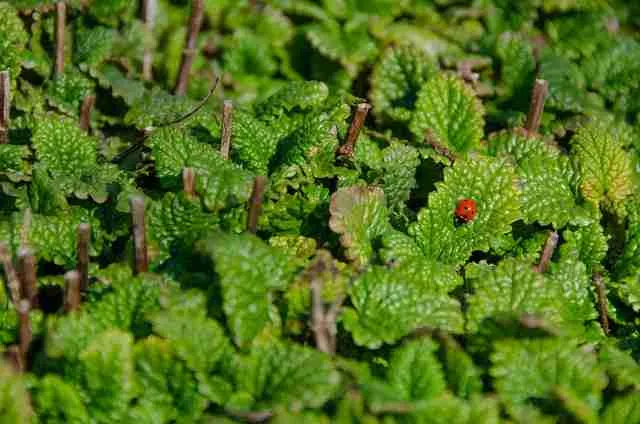
You will mind three major variations of mint in our grocery stores – wild, organic, and domestic.
However, before you buy the mint plant for your cavies, here are the plants under the mint family that are safe for their eating.
1. Peppermint:
Peppermint is the most common form of mint available in the market. You will find this mint variation as leaves, oil, or capsules.
Peppermint or Mentha Balsamea is a wild hybrid of the mint plant. Though they originated from Europe, these plants are now widely available around the globe.
These plants grow about 12-35 inches and are the perfect supplement to cure anxiety, diarrhea, and indigestion in the cavies.
2. Lemon Balm:
Lemon Balm or as otherwise called Beebalm, belongs under the mint family with the scientific name of Melissa Officinalis. These herbs are suitable for stress relief.
You can also feed lemon balm mint to your cavies to treat gastrointestinal issues in cavies.
3. Rosemary:
Rosemary is well known as a cooking herb with an exotic aroma among us, humans,
The presence of antioxidants in rosemary helps in immunity improvement in cavies.
This species of plant has other benefits as well. It helps in scurvy prevention and purifies the guinea pig blood.
4. Lavender:
If you didn’t know lavender belongs to the mint family, it is important to understand that lavender belongs to one of the healthy mint plants for guinea pigs.
Some of the major benefits Lavender provide to cavies are:
- Adds fragrance to the veggies salad you prepare for them.
- Purifies the cavy skin from toxic blood.
- The lavender aroma calms the mind and body of guinea pigs
- When you feed mint with other Vitamin C-rich veggies, you help them by preventing scurvy.
- The mint flower of lavender has low-calorie content. Hence, it is suitable for weight management.
What Kinds of Mint are Toxic to Guinea Pigs?
Pennyroyal is a toxic mint plant for our cavies. Though most of the locally available species under the mint family are more or less safe for feeding guinea pigs, you can’t feed pennyroyal.
Two categories of Pennyroyal plants are available around us-
- American Pennyroyal (Mentha Pulegium)
- European Pennyroyal (Mentha Pulegium)
Both the plants are equally harmful to guinea pigs. You must avoid feeding both to your cavies.
Since they both have similar uses, it is easy to get confused while buying mint from the market.
To distinguish between the two, the American Pennyroyal is commonly called the mock or false pennyroyal, and the European is known as squaw mint, mosquito plant, or simply pudding grass.
If you are still unsure, here is a piece of brief information for Pennyroyal identification.
Identifying Pennyroyals
You can distinguish between the American and European Pennyroyal by their flowers.
While the European pennyroyals have lilac-colored flowers with a strong spearmint fragrance, the American Pennyroyals have blue flowers.
They even have different types of leaves. The leaves of European Pennyroyals are orbicular or round-shaped. The American Pennyroyals, however, have erect and slender leaves.
Suggestion: Don’t try to identify them by crushing the flower or leaves. Both the plants have a strong minty smell.
How to Feed Guinea Pigs Mint?
When you feed mint to your guinea pigs, remember the below points before buying and preparing the meal:
- Always serve them fresh mint,
- Purchase either spearmint or peppermint only, and
- Avoid feeding wild mint
Once you have purchased fresh mint for your cavies, follow the below steps to prepare a healthy meal with mint in it.
Step 1: Thoroughly Wash the Mint Under Running Water
Washing the mint thoroughly under running water is important to remove all the dirt and chemicals from it.
The fresh mint you buy from the market is likely to have dirt and pesticides. Washing it makes the mint safer for cavies.
Step 2: Chop Mint into Medium-Sized Pieces
When you prepare a meal for your cavies with mint in it, make sure you are not adding too many mint leaves.
Pluck 1-2 leaves at a time and chop them up into medium-sized pieces.
Sprinkling medium-sized pieces of mint over the veggies salad improves the smell of the meal.
While it makes the food flavorful, the small quantity ensures that it is never harmful to your cavies.
Step 3: Mix Mint Leave Pieces With Veggie Salad
Your cavies might love mint in their meal, but it is not healthy to serve the mint leaves alone. It is always best to sprinkle small pieces of chopped mint leaves over their veggie salad.
Timothy hay is a staple for cavies. You can also try adding chopped mint with the hay to increase the flavor.
Step 4: Serve in Clean Plate
The final step of feeding mint to your cavies is serving. After you have prepared their veggie salad with mint, serve the salad on a thoroughly washed, clean plate.
It helps in avoiding germs.
Warning: Your duty as a cavy owner doesn’t end with feeding a healthy meal to your pet. Once they finish their meal, you need to clean their cages thoroughly.
Make sure there are no leftovers in the cage. An unclean cage with food leftover often attracts flies, bacteria, and even rats. It is harmful to the guinea pigs.
What Type of Mints Can You Serve to Guinea Pigs?
We understand the plant types under the mint family that are good for guinea pigs. Let’s find out the type of mints cavies can have.
Can Guinea Pigs Eat Apple Mint?
It depends. Apple mints are soft and woolly with rounded leaves.
Though this type of mint is not exactly harmful to your cavies, it might cause choking hazards in them.
You can chop bite-size pieces and give a small piece for your cavy to taste. Make sure you monitor them while feeding apple mint.
Can Guinea Pigs Eat Lemon Mint?
Yes. Lemon mints are safe for guinea pigs if you serve them in moderation.
There is a mild lemon flavor in the lemon mints, which enhances the flavor of our cavies’ food.
In addition, lemon mint is rich in antioxidants. This is helpful for guinea pigs to reduce inflammation.
However, feed a small piece to your cavy to understand their choice. Not all guinea pigs enjoy lemon mint.
If your guinea pig loves the taste, you can feed 2-3 leaves of the lemon mint once or twice a week.
Can Guinea Pigs Eat Wild Mint?
No. Wild mint is not a healthy option for guinea pigs.
Wild mint is likely to have fungi or bacteria that lead to illness in guinea pigs. In fact, these mints are often dangerous.
So it is best to avoid wild mint and serve fresh homegrown mint to your cavies.
Can Guinea Pigs Eat Garden Mint?
Absolutely yes. Garden mint is the best type of mint for your cavies.
It is important that you provide fresh and original parts of the mint to your cavies instead of canned or dried ones.
Mint grown in your garden helps you serve fresh and free from germs.
Growing mint in your garden is an easy job. Moreover, these are safer mints as they don’t have any chemicals and pesticides in them.
However, even a homegrown mint can be affected by bacteria and fungi.
Therefore, it is recommended to wash the mint thoroughly under running water before serving to remove bacteria, even if it is grown in a garden.
Read Also: Can Guinea Pigs Eat Onions from the Garden?
Can Guinea Pigs Eat Chocolate Mint (Plant)?
Absolutely yes. Guinea pigs can safely eat chocolate mint.
The chocolate mints come from the peppermint plant and hence are rich in Vitamin A. We already know that Vitamin A improves guinea pigs’ health in different ways.
To add to the benefits of chocolate mint, the mint leaves taste too good. Naturally, our cavies love eating chocolate mints.
Can Guinea Pigs Eat Sweet Mint Leaves?
Yes. Guinea Pigs can eat sweet mint, but only in moderation.
The sweet mint leaves are not nutritious but high in calcium and sugar content. Hence, it is best to serve these leaves on occasions as a treat only.
Can Guinea Pigs Eat Vietnamese Mint?
It depends. Vietnamese Mint, also called Vietnamese Coriander, has a fiery or peppery flavor.
Though there is no harm in feeding Vietnamese mint to your cavies in small quantities as a treat, it is not necessary that they will like it.
Guinea pigs often tend to avoid this type of mint because of the peppery flavor.
Other Healthy Alternatives of Mint for Guinea Pigs
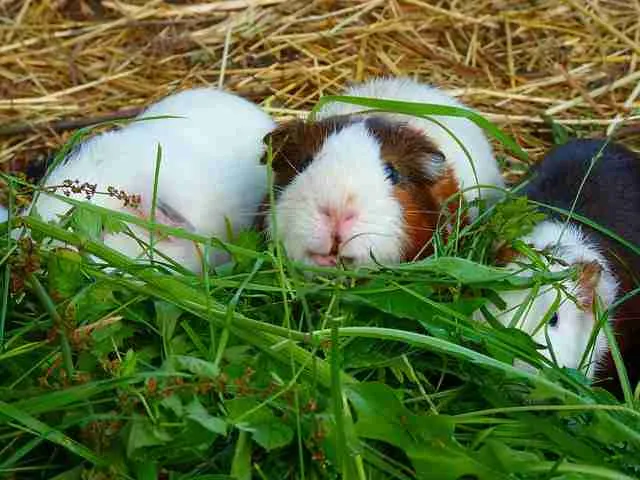
Mint is a safe herb for guinea pigs. But not all herbs are good for them.
Here are some healthy alternatives of mint for guinea pigs that you can buy from the market and feed in moderation with other vegetables.
FAQs
Can Guinea Pigs Eat Fresh Mint?
Yes, Fresh mint is the only suggested option for guinea pigs.
Never feed them any other form of mint than the fresh ones. The fresh ones retain all the nutrients, even if the content is low.
Cooked or dried mint loses all its health benefits. But when you feed fresh mint to your cavies, they get the important nutrients for their health.
Can Guinea Pigs Eat Dried Mint?
Yes, guinea pigs can eat dried mint. However, powdered and dried mint is not a good option for our cavies.
Though dried mint is a common option in the market for most of us, it is best to avoid those packs and purchase fresh ones.
Dried mint can be dangerous for your cavies at times, leading to digestive problems.
Can You Give Guinea Pigs Mint Tea?
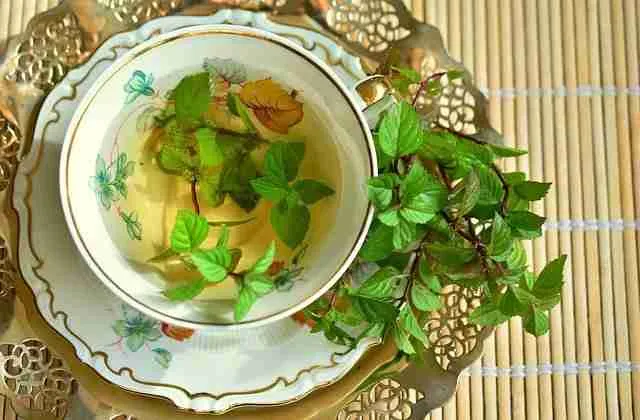
It depends. If you are making herbal tea for your guinea pig with mint, you can serve a small portion to them.
In most cases, tea is a harmful beverage for cavies as they are mostly inorganic with added sweeteners and colors. Artificial colors are harmful to cavies.
But if your guinea pig likes the taste of mint, you can always prepare a herbal tea from mint leaves and serve it to the cavy.
Try by serving a small portion to see their reaction to the mint tea. If they are enjoying it, you can serve the mint tea as a treat for them.
Can Nursing Guinea Pigs Have Mint?
No. You shouldn’t feed mint to nursing guinea pigs. It can dry up the mother’s milk and harm the babies.
A nursing guinea pig needs a healthy diet with good nutrients. Mint lacks all the important nutrients needed by a nursing guinea pig, like Vitamin C.
However, mint leaves have a small benefit for the baby guinea pigs. It prevents serious illnesses like Chronic Mastitis in weaning guinea pigs.
Is Mint Candy Safe for Guinea Pigs?
Absolutely not. Mint candy is very harmful to guinea pigs as it affects their digestive system.
Guinea pigs have a sensitive and weak digestive system that fails to digest mint candy. Plus, they can’t easily chew this type of candy.
There is always a high chance that your cavy choking over mint candies. So, it is a big NO when it comes to feeding mind candies to your cavies.
Final Thoughts
So far, we have found out that mint is safe for guinea pigs. They can eat both spearmint and peppermint.
All parts of the plant are safe for guinea pigs to eat, except for the roots. In fact, the majority of the mint species are edible other than the Pennyroyal variation.
Though our cavies love to eat mint, you should provide them mint in moderation only. Since the nutritional content of mint is low, you shouldn’t feed them mint more than twice a week.
No matter what type of mint you serve, make sure it is fresh.
If you found this article helpful, don’t forget to share the article with other guinea pig lovers!
